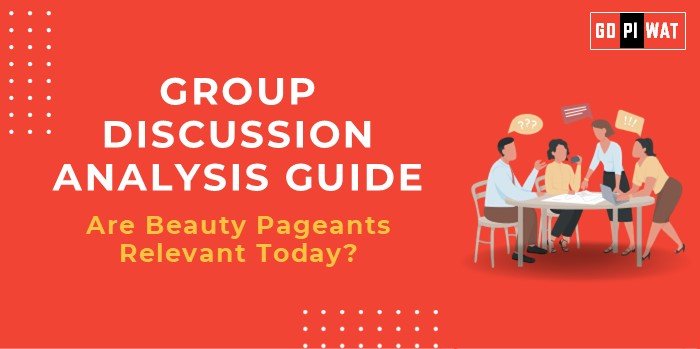📋 Group Discussion (GD) Analysis Guide on “Are Beauty Pageants Relevant Today?”
🌐 Introduction to Beauty Pageants
Beauty pageants have long held a place in global culture, promoting ideals of beauty, grace, and philanthropy. Once widely celebrated for their influence on fashion, charity, and entertainment, beauty pageants now face criticism regarding their cultural relevance, inclusivity, and impact on self-image. This topic invites debate on whether beauty pageants are evolving to meet modern social standards or if they represent outdated traditions.
📊 Quick Facts and Key Statistics
- 💸 Market Size: The global beauty pageant industry is valued at around $2 billion, highlighting its ongoing economic influence.
- 🌍 Inclusivity: Recent pageants, such as Miss Universe, have introduced “inclusive” categories, including for married women and mothers.
- 📉 Impact on Body Image: Studies link pageant culture with body dissatisfaction, as 58% of young women report being negatively impacted by beauty standards in media.
- 📺 Viewership Decline: Traditional TV viewership for Miss America and Miss Universe has dropped by over 50% in the last decade, suggesting waning interest.
- 📈 Growth of “Inner Beauty” Movements: Social media has seen a rise in body positivity and self-acceptance campaigns, reshaping beauty norms.
👥 Stakeholders and Their Roles
- 🏛️ Organizing Committees: Organizations like Miss Universe and Miss World set the standards for competition, inclusivity, and participant welfare.
- 👩🎤 Participants: Pageant contestants contribute to the event’s diversity and appeal, often balancing career aspirations with pageant preparation.
- 📺 Audience: Viewers shape pageant success and influence trends, pushing pageants to adapt to changing social values.
- 💼 Sponsors: Corporations financially support pageants but may withdraw support if public perception grows critical.
- 🌈 Social Advocates: Body positivity activists challenge traditional pageants and promote broader definitions of beauty.
🎯 Achievements and Challenges
🏆 Achievements:
- 🌟 Cultural Impact: Pageants have brought awareness to social causes like education, HIV/AIDS prevention, and mental health.
- 👩🎤 Diversity: Some pageants now promote broader beauty ideals, featuring contestants of different body types, ages, and backgrounds.
- 💸 Economic Contributions: Pageants contribute to tourism and local economies by hosting large events that attract international audiences.
⚠️ Challenges:
- 💔 Body Image Issues: Critics argue that pageants often perpetuate unrealistic beauty standards.
- 📉 Relevance: As social values shift, traditional pageants may seem outdated, especially in societies prioritizing self-acceptance and inclusivity.
- 🌏 Global Comparisons: While the U.S. pageant industry declines, countries like the Philippines maintain robust interest, reflecting cultural differences in beauty perceptions.
🗣️ Structured Arguments for Discussion
✅ Supporting Stance:
“Beauty pageants offer a platform for women to showcase talents, raise awareness for causes, and cultivate career opportunities in media, fashion, and philanthropy.”
❌ Opposing Stance:
“Traditional beauty pageants promote narrow, outdated standards of beauty that contribute to body dissatisfaction and social inequality.”
⚖️ Balanced Perspective:
“While beauty pageants still hold cultural and economic significance, they must evolve to embrace a more inclusive vision of beauty and personal achievement.”
💡 Effective Discussion Approaches
🔑 Opening Approaches:
- 📊 Statistical Impact: “With a market value of $2 billion, the beauty pageant industry remains a cultural force, but recent trends reveal a shift in viewer values.”
- 🌈 Contrast Approach: “In a world promoting body positivity, traditional beauty pageants may seem irrelevant—but are they evolving to keep up?”
- 📜 Case Study: “The inclusion of mothers in the 2023 Miss Universe pageant demonstrates a move toward inclusivity, sparking debate on the industry’s future.”
⚡ Counter-Argument Handling:
- Address criticisms of beauty standards by highlighting recent pageant reforms, like Miss Universe’s inclusivity measures.
- Emphasize how pageants can evolve to reflect modern values while maintaining their cultural and economic significance.
🔎 Strategic Analysis of Strengths and Weaknesses (SWOT)
- 💪 Strengths: Public influence, charity work, cultural visibility.
- ⚡ Weaknesses: Declining viewership, criticism on inclusivity, societal impact on body image.
- 🌟 Opportunities: Rebranding to focus on diversity, collaboration with social campaigns.
- ⚠️ Threats: Competition from digital platforms, increased criticism from social activists.
🏫 Connecting with B-School Applications
📖 Real-World Applications:
This topic connects to B-school themes like branding, social responsibility, and changing consumer behavior.
📋 Sample Interview Questions:
- “How should pageants adapt to align with today’s social values?”
- “What can beauty pageants teach us about branding in a changing market?”
Insights for B-School Students: Understanding the shift in beauty standards is crucial for those interested in marketing, public relations, or social advocacy.


